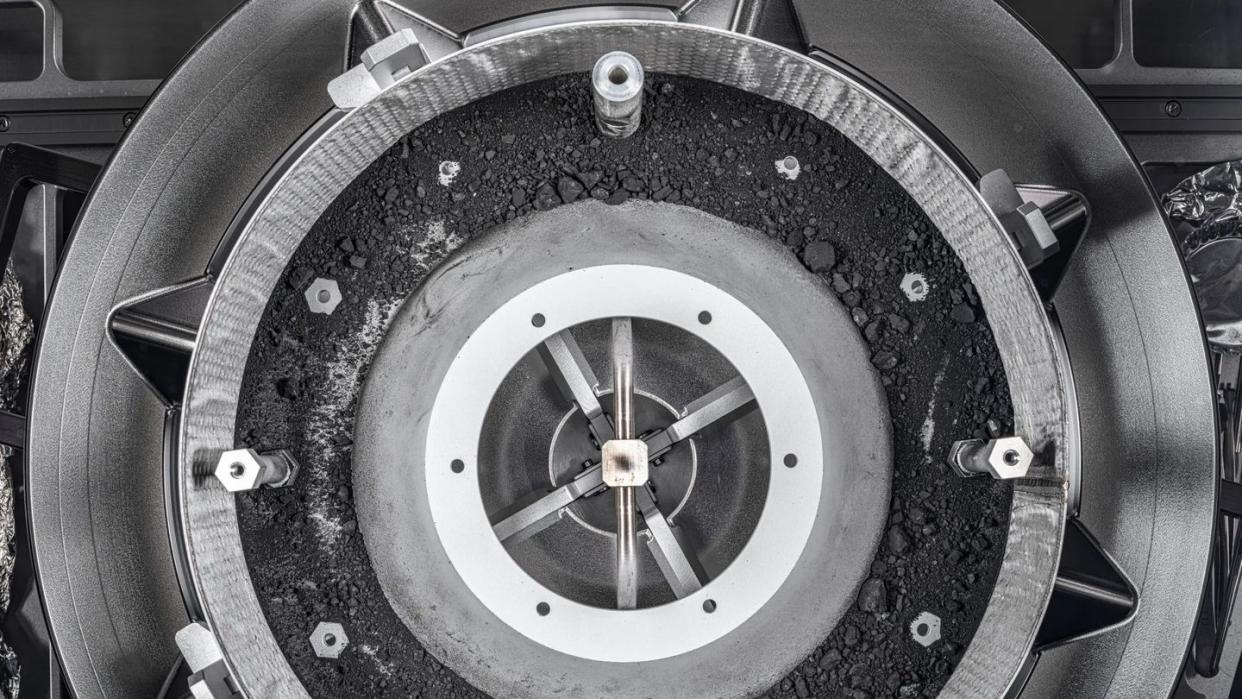NASA Finally Pried Open a Canister of 4.6-Billion-Year-Old Asteroid Dust

After 20 years of planning, building, launching, and waiting, NASA finally accessed the last of the Bennu asteroid sample from the OSIRIS-REx sample retrieval mission, which returned to Earth this past September.
For months, the sample remained locked behind two stubborn fasteners that wouldn’t open, but NASA developed a work around that also protected the integrity of the sample.
The missions isn’t over, as OSIRIS-APEX is now on its five-year mission to reach the asteroid Apophis as the object makes a startlingly close Earth approach in April of 2029.
The Origins, Spectral Interpretation, Resource Identification, and Security-Regolith Explorer—known more commonly (thank goodness) as OSIRIS-REx—is one of NASA’s most ambitious missions in recent memory. As its alphabet soup of a name suggests, this spacecraft arrived on a carbon-rich asteroid named Bennu to retrieve a sample of its regolith. That asteroid material will hopefully help scientists get a better understand the origins of our Solar System, and even life on Earth.
And by all metrics, the mission was a success (though it’s far from over…more on that in a second).
After the asteroid sample landed in the Utah desert in September, NASA conducted a “quick look analyses” using an electron microscope, and gathered X-ray diffraction data and chemical element analyses the following month. The team concluded that the coffee cup-sized sample was indeed rich in carbon and water—the elements that make life tick on Earth.
However, NASA ran into a small hiccup when trying to unpack the rest of the sample—two fasteners (out of 35) on the Touch-and-Go-Sample-Acquisition-Mechanism (TAGSAM) head, pictured above, were stuck in place. After traveling millions of miles, precious samples of otherworldly dust and rocks (some up to 0.4 inches in size) remained frustratingly out of reach.
Being wary to not contaminate the sample, NASA engineers finally found a way to successfully remove the two fasteners last week, and began the process of retrieving the sample. “Our engineers and scientists have worked tirelessly behind the scenes for months […] to design, develop, and test new tools that allowed us to move past this hurdle,” Eileen Stansbery, division chief for ARES (Astromaterials Research and Exploration Science) at NASA’s Johnson Space Center, said in a statement on January 11.
Finally, on Friday, NASA announced they’d retrieved the rest of the sample, and that all of the goods gathered by OSIRIS-REx had been safely delivered into the space agency’s (non-contaminating) hands. This sample joins around around 70 grams of Bennu dust collected from the outside of the sample head, as well as a portion of the sample inside—far exceeding the original mission goal of bringing back 60 grams of sample in total.
Once the team removes the round metal collar, the samples will be transferred to pie-wedge sample trays. Johnson Space Center will host 70% of the collected sample in storage for future study, and other portions will be sent to the Smithsonian Institution and the University of Arizona for display.
While scientists are only beginning to understand the bounty delivered by OSIRIS-REx, the spacecraft itself—now named OSIRIS-APEX, where APEX means Apophis Explorer—has its sights set on another target. Next up, it will approach the asteroid Apophis, which will make an incredibly close swing-by of Earth in April of 2029. It will actually get closer to us than the highest man-made satellites in orbit around Earth. This extremely close encounter will give scientists an unprecedented opportunity to study how a close approach to a larger gravitational body like Earth can impact asteroids—whether creating earthquakes or landslides on its surface, or altering its orbit.
Like OSIRIS-REx, OSIRIS-APEX will use its impressive suite of scientific tools, including imagers, spectrometers, and a laser altimeter to peer at Apophis’ chemical makeup. The spacecraft will also fire its downward thrusters so scientists can peek beneath the asteroid’s surface layer.
So, while Earth-bound scientists are still poring over the spacecraft’s first asteroid delivery Bennu is fully in the rearview for OSIRIS-APEX. Can’t keep a good craft down.
You Might Also Like
